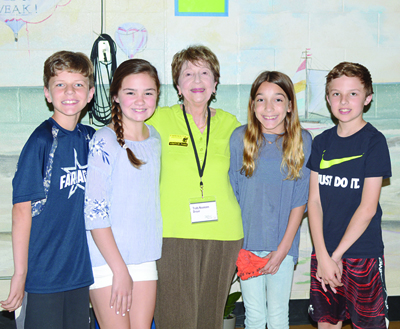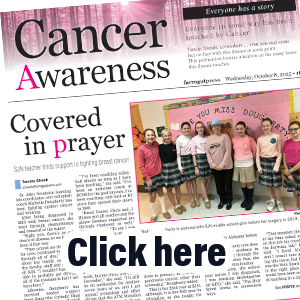A Survivor's Story
Dreyer, Holocaust survivor, shares ‘the scariest time of my life’ with FIS fifth-graders
 Trudy Dreyer chats with Farragut Intermediate School fifth-graders, from left, Tyler Slatos, Carson Kraemer, Cora Esquivel and Ephrym Wilkinson, after speaking about her Holocaust experience at FIS Wednesday, May 9.
Trudy Dreyer chats with Farragut Intermediate School fifth-graders, from left, Tyler Slatos, Carson Kraemer, Cora Esquivel and Ephrym Wilkinson, after speaking about her Holocaust experience at FIS Wednesday, May 9.
“It was the scariest time of my life,” said Dreyer, who shared her story with Farragut Intermediate School fifth-graders Wednesday, May 9.
Living in Knoxville, Dreyer, 86, said she wants to tell what happened to German Jews and the laws that were passed under Adolf Hitler’s reign starting in 1933.
“… And the fact (Hitler) was so charismatic,” she said.
FIS fifth-graders have been studying the Holocaust as part of their curriculum, FIS social studies teacher Angie Maxey said.
“Until just a few years ago, it wasn’t part of the curriculum, and I had to get permission for fifth-graders to hear it; but now that it’s part of the curriculum, I’m amazed and elated,” Dreyer said after her address.
“It’s one of our social study standards,” Maxey said. “We (study) this, so history doesn’t repeat itself. We never want to see anyone persecuted or bullied because of a belief or the way (people look) because it’s different.
“You are the future, and you can be the change and you can make (events like the Holocaust) never, ever happen again,” she told the fifth-graders.
“I learned there are a lot more than survivors from concentration camps,” FIS fifth-grader Tyler Slatas said. “There are also more survivors, like people who were coming over to America on ships and soldiers on the Allied team.
“I got that it doesn’t matter what color your skin is or type of hair you have … it’s just that everybody should be equal,” added Tyler, who said he is part Jewish.
“I realized that the Holocaust and concentration camps are really bad,” fifth grader Cora Esquivel said, adding she had toured a German concentration camp two years ago. “It’s really sad. People should never be treated like that.”
Cora said she learned “to never treat people badly and to never judge because it’s a horrible thing.”
“I learned how terrible the Holocaust was and how people were treated terribly,” fifth-grader Carson Kraemer said.
She also learned to “always treat people equally, even if they are different.”
While Dreyer talked, students quietly listened, eyes on their speaker. After the assembly, many children stood in line to hug or hand her a written “thank you.”
“There are deniers that it happened,” Dryer said. “Those who are deniers need to be in contact with people who experienced the Holocaust, particularly the concentration camp.”
In Unsleben, her father, Nathan Naumann, and brother had owned a grainary until it was taken away, she said.
“Unsleben had about 10,000 people in it, and a little more than 100 of them were Jews,” Dreyer said. “In 1933, Hitler approved decrees banning Jews and other non-Aryans from the practice of law and anything that had to do with Christians.”
Among thousands of decrees issued, Jewish doctors and dentists could not treat Christians; teachers could not teach Jewish children in a public school; and Jewish teachers could not teach Christian students.
The Jewish people were excluded from the military, voting and citizenship, and passports were restricted. “Everything was banned for Jews,” she recalled.
“It became law to denounce neighbors if they didn’t conform to the (Nazi) commandments,” Dreyer added. “Even if Christians were friendly to Jews, those who were Nazis told on (the Christians).”
The Nazis used violence to create a system so efficient in controlling the population that most people “accommodated to the situation,” Dreyer said.
“(The state secret police) ran everything,” Dreyer said of the Gestapo. “They were permitted to do anything they wanted to the Jews. They went into houses, they beat up people, they murdered people, they did terrible things — but they had Hitler’s permission.
“There was nothing we could do about it. Absolutely nothing,” she added. “Little by little, things were taken from us. Life became intolerable for us.”
The concentration camps also started in 1936.
“One of the first concentration camps was Dachau, which was in Bavaria, not too far from Unsleben,” Dreyer said.
One night, about 30 to 40 men came to her house, yelling for her father to come out of the house.
“We were powerless — there were no police (in the town to take her father into protective custody),” she said. “Our cries for help remained unanswered.”
Dreyer was 6 years old when she witnessed the men beat her father. “The noise was terrible. It lasted more than a half an hour,” she recalled. “Each (of the men) had to participate in the beating.
“He was never the same after that,” she observed.
Then on Nov. 9, 1938, Nazi SS troops went to every city and town in Germany.
“Homes of Jews were broken into,” Dreyer said. “All the synagogues were desecrated.”
All the symbols of their worship were taken to the center of town and burned in a bonfire.
“My father was dragged out of the house, and he was taken to Dachau,” Dreyer said. “One uncle hanged himself because he was so afraid. So many (men0 were beaten so badly they didn’t survive Dachau.”
However, Dreyer’s father and many others “saw the writing on the wall” early on and applied for visas to leave the country.”
While her father was in Dachau, the visa came through and he was released. “I was just so elated,” she recalled. “I didn’t know if he would get out or not, and my mother was a basket case.”
Dreyer was 7 years old when her family left Germany and embarked for Cuba, where they lived for a year in a Havana ghetto, until they were allowed into the United States.


